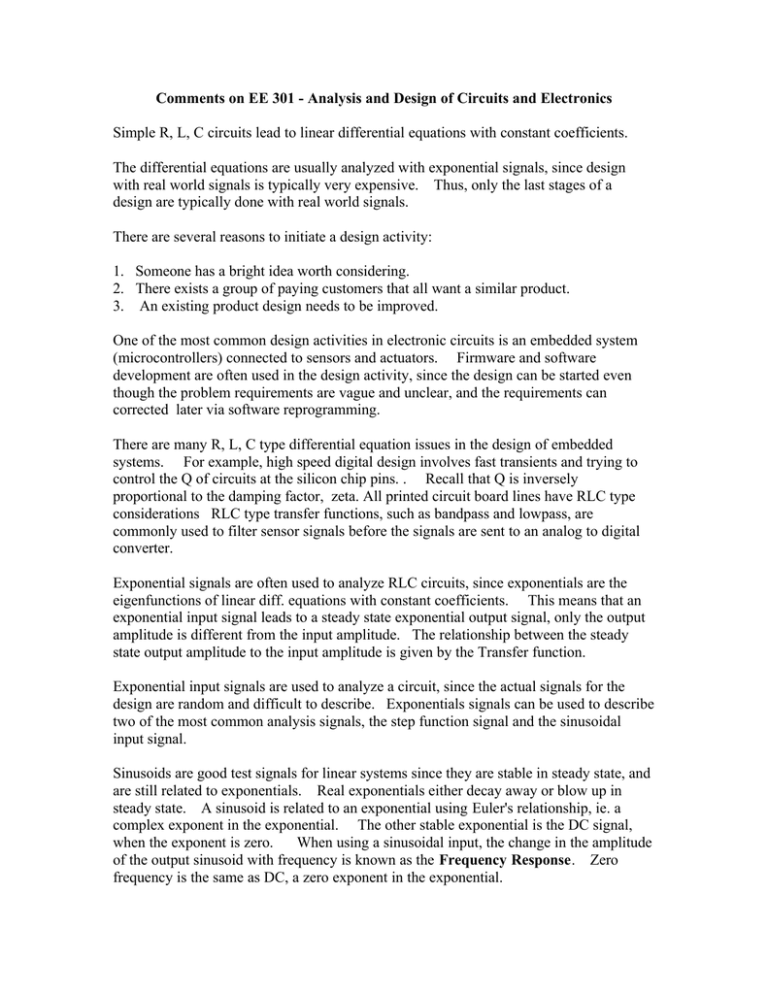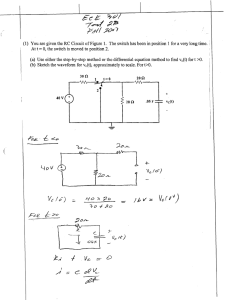Observations
advertisement

Comments on EE 301 - Analysis and Design of Circuits and Electronics Simple R, L, C circuits lead to linear differential equations with constant coefficients. The differential equations are usually analyzed with exponential signals, since design with real world signals is typically very expensive. Thus, only the last stages of a design are typically done with real world signals. There are several reasons to initiate a design activity: 1. Someone has a bright idea worth considering. 2. There exists a group of paying customers that all want a similar product. 3. An existing product design needs to be improved. One of the most common design activities in electronic circuits is an embedded system (microcontrollers) connected to sensors and actuators. Firmware and software development are often used in the design activity, since the design can be started even though the problem requirements are vague and unclear, and the requirements can corrected later via software reprogramming. There are many R, L, C type differential equation issues in the design of embedded systems. For example, high speed digital design involves fast transients and trying to control the Q of circuits at the silicon chip pins. . Recall that Q is inversely proportional to the damping factor, zeta. All printed circuit board lines have RLC type considerations RLC type transfer functions, such as bandpass and lowpass, are commonly used to filter sensor signals before the signals are sent to an analog to digital converter. Exponential signals are often used to analyze RLC circuits, since exponentials are the eigenfunctions of linear diff. equations with constant coefficients. This means that an exponential input signal leads to a steady state exponential output signal, only the output amplitude is different from the input amplitude. The relationship between the steady state output amplitude to the input amplitude is given by the Transfer function. Exponential input signals are used to analyze a circuit, since the actual signals for the design are random and difficult to describe. Exponentials signals can be used to describe two of the most common analysis signals, the step function signal and the sinusoidal input signal. Sinusoids are good test signals for linear systems since they are stable in steady state, and are still related to exponentials. Real exponentials either decay away or blow up in steady state. A sinusoid is related to an exponential using Euler's relationship, ie. a complex exponent in the exponential. The other stable exponential is the DC signal, when the exponent is zero. When using a sinusoidal input, the change in the amplitude of the output sinusoid with frequency is known as the Frequency Response. Zero frequency is the same as DC, a zero exponent in the exponential. The lack of a good description of the actual input signals is one of the paradoxes of circuit design. There are several other circuit design paradoxes. One, the initial state of a RLC circuit is often unknown or random. The initial state describes the initial stored energies in the capacitors and inductors. Two, there are issues of practicality and manufacturability. Inductors are very expensive compared to resistors and capacitors. Off the shelf capacitors have poor accuracy, often with 20% errors or more. Besides the frequency response, the other key behavior of a linear circuit is in terms of the transient, or natural response. The natural response is the other solution to linear differential equations (besides the forced response). The sum of the natural response and the forced response is known as the total solution. The form of the natural response of constant coefficient, linear differential equations is the exponential signal, the same as the eigenfunction. This is not an accident, but is a key reason why we use forcing input signals that are the same as the natural response. In this case, the forced response and the natural response are related, and cannot be specified independently of each other. In circuit design, the tradeoff between the desired natural response and the desired forced (or frequency response) is a critical design constraint. A design activity often involves six or more stages. They are: Concept, Study, Requirements Specification, Design, Build, and Test. Often, several loops must be made through each stage. In challenging designs, the Requirements Specification is often the most confusing stage to produce accurate content. Many electronic circuit designs have a desired frequency response and a desired natural response specified for the project. Often, these two desired responses are compromised against each other. We often analyze the desired behavior of a circuit in the s domain, without using the differential equation. Usually, for complex circuits (eg. dozens of nodes), deriving the needed differential equation directly from the component differential equations (I = C*dV/dt, etc.) is very error prone. The idea of an s domain strategy is based on the observation that A*exp(st) is an eigenfunction of RLC systems, and allows for algebraic and systematic resistor procedures to be used. Systematic resistor procedures (combinations such as parallel, series, dividers, etc.) also reduce introduction of errors. The relationship of the two responses is embodied in the Transfer function, T(s) = N(s)/D(s). D(s) is the denominator of the transfer function. The roots of the D(s) = 0, called the characteristic equation, yield the exponents used in the exponentials of the natural response. The magnitude of D(s=jw), controls the shape of the frequency response when the frequency w is swept from low to high frequencies. A common requirements specification in the frequency response is the bandwidth of the response. A basic tradeoff in linear circuits is that one can not have fast natural responses and narrow bandwidths at the same time, which is unfortunate, since such a requirement is common in information technology. To get fast natural responses means using wide bandwidth, and wide bandwidth makes interference signals much harder to deal with. Wide bandwidth systems are also more difficult to build, incurring increased costs, more power usage, and exacerbate component material limits. Facts you should know: Reasons for analyzing circuits with Sinusoidal inputs. Sinusoidal Inputs lead to easily calculated Sinusoidal Outputs. Don't have to write down the differential equation, and can use simple resistor combinations like series, parallel, dividers, Thevenin equivalents, etc. Most input signals can be described as a sum of many Sinusoids (Fourier Series). An infinite number of complex exponential sinusoids are used in the Laplace transform. Real input signals are random and only partially known. Many times this partial knowledge is described in the frequency domain. Calculating a frequency component of a signal is an averaging operation, and averages are a good thing to use with real world signals, since the signals are random. The Sinusoidal response as a function of frequency also gives an idea of the transient, or natural response. Other facts: At DC (zero frequency), a capacitor behaves as an open circuit, while an inductor behaves as a short. The behavior is reversed at high frequencies (eg. infinite): a capacitor is a short while an inductor is an open circuit. Some paradoxes in circuit design come from signal analysis. 1. Information carrying signals are random, which means that solving the input/output transfer is difficult for real world systems. 2. The initial conditions are usually random also. 3. Component values are not exact, but have a random variation due to the manufacturing process. In a linear circuit (& linear system), the rate of decay in the transient response is inversely proportional to the bandwidth in the frequency response. The time constant of decay is the inverse of the 3db bandwidth. This applies to both lowpass and bandpass frequency responses. The bandwidth of a high pass response is not really defined, and a real high pass circuit (out to infinite frequencies) does not really exist. Given a transfer function that has a rational form of N(s)/D(s), one can get produce the differential equation by noting that D(s) produces the characteristic equ., and N(s) produces the operations (such as derivatives) on the input signal. Resonance occurs when the input forcing function has a frequency that is very close to a pole of the natural response. When this happens, D(s) in the transfer function becomes very small, and T(s) can be much larger than 1. The magnitude of T(s) in a resonance region is related to the inverse of the damping factor, zeta. When zeta is small, eg. .05, the poles are complex conjugates and very close to the jw axis in the s plane. Pole-zero diagrams in the s plane are a good tool to visualize how the forced response and the natural response will be traded off against each other. The transfer function T(s) of a system turns out to be the Laplace transform of the impulse response of that system. Recall that the impulse response is about the same as the natural response, except that the amplitudes of the natural response are now determined (which is the zero state response, ie. the initial stored energies are zero). This is another example that shows that the natural response and the forced response are related. If we design a system to produce a particular desired transient response, then the Laplace transform of that particular transient response will produce the transfer function T(s). T(s) will then determine the frequency response, and hence the bandwidth of the forced response.


